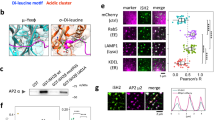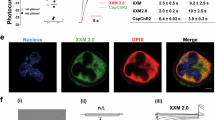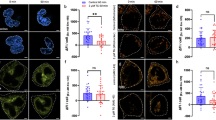Abstract
Aim:
To investigate the mechanism of chlorogenic acid (CA)-induced anaphylactoid reactions.
Methods:
Degranulation of peritoneal mast cells was assayed by using alcian blue staining in guinea pigs, and the degranulation index (DI) was calculated. CA-induced degranulation of RBL-2H3 cells was also observed and assayed using light microscopy, transmission electron microscopy, flow cytometry, and β-hexosaminidase release.
Results:
CA 0.2, 1.0, and 5.0 mmol/L was able to promote degranulation of peritoneal mast cells in guinea pigs in vitro, but it did not increase the degranulation of peritoneal mast cells in CA-sensitized guinea pigs compared with control (P>0.05). Treatment with CA 0.2, 1.0, and 5.0 mmol/L for 30, 60, and 120 min induced degranulation in RBL-2H3 cells in a dose- and time-dependent manner (P<0.01). Under transmission electron microscope typical characteristics of degranulation, including migration of granular vesicles toward the plasma membrane and integration combined with exocytosis, were observed, after CA or C48/80 treatment. Fluorescent microscopy and flow cytometric analysis showed that CA induced concentration-dependent translocation of phosphatidylserine in RBL-2H3 cells. β-hexosaminidase release in RBL-2H3 cells was significantly increased after incubation with 1 mmol/L CA for 60 min and 5 mmol/L CA for 30 min (P<0.01).
Conclusion:
CA induces degranulation of peritoneal mast cells and RBL-2H3 cells in guinea pigs, which might be one of the mechanisms of the generation of anaphylactoid reactions induced by CA.
Similar content being viewed by others
Log in or create a free account to read this content
Gain free access to this article, as well as selected content from this journal and more on nature.com
or
References
Lai YH, Chen HA, Yang WR . Allergy research of Chinese medicine injections should be strengthened. Tradit Chin Drug Res Clin Pharmacol 2002; 13: 324–6. Chinese.
Liang JQ, Zou YP, Den XC . Literature survey and analysis of adverse effects of Chinese medicine injections. Chin J Hosp Pharm 2003; 23: 40–2. Chinese.
Han QM, Jiang YF, Wu JH . Literature analysis of adverse effecto of Chinese medicine injections in our hospital. Xinjiang J Tradit Chin Med 2003; 21: 55–6. Chinese.
Huang FH . Safety analysis of traditional Chinese medicine injections with chlorogenic acid. China J Chin Mater Med 2008; 33: 2716–9. Chinese.
Berkes EA . Anaphylactic and anaphylactoid reactions to aspirin and other NSAIDs. Clin Rev Allergy Immunol 2003; 24: 137–47.
Leone R, Conforti A, Venegoni M . Drug-induced anaphylaxis: case/non-case study based on an italian pharmacovigilance database. Drug Saf 2005; 28: 547–56.
Chen F, Shi YQ, Qin HD, Liu ZP . Inquiry into the biomarkers of drug anaphylactoid reactions. Chem Life 2008; 28: 795–8. Chinese.
Sun L, Liu XM, Wang X, Qi WH, Shen LZ, Li B . Discover the reason of allergic reactions induced by Tween-80 in animals. J Toxicol 2007; 21: 322. Chinese.
Luo F, Bao X, Lin DS, Yang HR, Zhou S, Xu XP . Allergic study of chlorogenic acid to animal. West China J Pharm Sci 2009; 24: 181–3. Chinese
Li JF, Li Y, Chen Q, Cheng ZH, Tang S . Research of the Immuontoxity of Shuanghuangliana Injection. Tradit Chin Drug Res Clin Pharmacol 2008; 19: 172–4. Chinese.
Siraganian RP, McGivney A, Barsumian EL, Crews FT, Hirata F, Axelrod J . Variants of the rat basophilic leukemia cell line for the study of histamine release. Fed Proc 1982; 41: 30–4.
Ortega E, Schweitzer-Stenner R, Pecht I . Possible orientational constraints determine secretory signals induced by aggregation of IgE receptors on mast cells. EMBO J 1988; 7: 4101–9.
Funaba M, Ikeda T, Abe M . Degranulation in RBL-2H3 cells: regulation by calmodulin pathway. Cell Biol Int 2003; 27: 879–85.
Ikawati Z, Wahyuono S, Maeyama K . Screening of several Indonesian medicinal plants for their inhibitory effect on histamine release from RBL-2H3 cells. J Ethnopharmacol 2001; 75: 249–56.
Martin SJ, Reutelingsperger CP, McGahon AJ, Rader JA, van Schie RC, LaFace DM, et al. Early redistribution of plasma membrane phosphatidylserine is a general feature of apoptosis regardless of the initiating stimulus: inhibition by overexpression of Bcl-2 and Abl. J Exp Med 1995; 182: 1545–56.
Demo SD, Masuda E, Roosi AB, Throndset BT, Gerard AL, Chan EH, et al. Quantitative measurement of mast cell degranulation using a novel flow cytometric annexin-V binding assay. Cytometry 1999; 36: 340–8.
Acknowledgements
This work was supported by the Chinese Medicine Industry Research and Special Project (No 200707008) and by the Natural Science Foundation of Zhejiang Province (No Y206846).
Author information
Authors and Affiliations
Corresponding author
Rights and permissions
About this article
Cite this article
Huang, Fh., Zhang, Xy., Zhang, Ly. et al. Mast cell degranulation induced by chlorogenic acid. Acta Pharmacol Sin 31, 849–854 (2010). https://doi.org/10.1038/aps.2010.63
Received:
Accepted:
Published:
Issue date:
DOI: https://doi.org/10.1038/aps.2010.63



